RMAF 2005
|
2005 Rocky Mountain AudioFest (Part One) |
| Audiophiles one mile high! |
Denver, Colorado.
Thought I was going to get a nose bleed. I’m told by the cabbie the city is located 5,000 feet above sea level (some quoted as much as 15,000). Didn’t know what that meant until I arrived at the Rocky Mountain Audio Fest. The very second I drew my handy camera out I started feeling uneasy. First thought was the guy sneezing on the plane seated directly behind me caught up and infected me. Rats. Ran into Mike Kochman of Echo Busters and he informed me that the likely culprit was the altitude. Though relieved, I didn’t feel any better until I downed about two quarts of bottled water.
The $59.00 taxi from the airport to the Denver Tech Center tells you either the show was held quite a distance from the airport or the driver knew I was from New York…and charged me accordingly! Here I thought I was getting away from all the hustle and bustle and I got hustled and near busted! Something told me this cabby saw a died-in-the-wool audiophile, full of riches and rewards, with plenty to spend, in his wide angle rear-view mirror. To illustrate how rich I was I made a record of his ID number and promised I would seek an investigation. Denver is absolutely beautiful however, the snow-capped mountains, and wide open land contrasted by its city skyscrapers gives an appeal I’ve not encountered in all of my travels. Maybe the cabbie took the scenic route?
But the highlight of my trip wasn’t the incredible views, great sounding rooms or Denver’s strength of local audiophiles, whom many I met for the first time. The highlight was seeing my old friend George Black. He and I grew up together and Ihadn’t seen or spoken with in over ten years. Family and proximity can have that effect. George, once a star basketball player in high school and college, gave me fits on NY’s basketball courts back in the early ’80s when I dreamed of one day making the pros. Admittedly, I didn’t like him that much on the court because he was so much more naturally gifted than I and was standing in the way of my dreams. Off the court, he was one of the cool cats who I secretly admired. All I knew was that he relocated to Denver back in ’98 or thereabouts, got into the real estate market and is doing quite well for himself. I simply got in touch with him through a mutual friend and just like that we hooked up after all these years. We chatted like two noisy housewives at a tea party.
Okay, back to the show…
Colorado Audiophile Sound and Design’s Randall Marder and and local New JerseyiteBill Parrish of GTT Audio (photo above) put together these beautifully finished Kharma Audio products. Parrish proudly displays the new Kharma MP-150 mono amp which I’m almost certain, based on its size, is running DSP somewhere in its circuit (switching power supply I’m informed) ala the NuForce our Frank Alles swooned over. Don’t let the size fool you because this 150-watt book-end look-alike took control of the Kharma 3.2s in a way that could only be described as viscerally pleasing. Personally, I was shocked at how good this setup sounded considering how the Kharma’s were always paired with Lamm amplification at previous venues. The Kharma CsSb model powered sub only provided the subterranean bass that many choose not to live without. Parrish makes no bones about what he considers as giant killers in the MP-150s ($6800/pair). I could not have agreed more. I think it will be tough however convincing audiophiles what this little dynamo can do. This baby slaps the testosterone out of the big boys.
________________
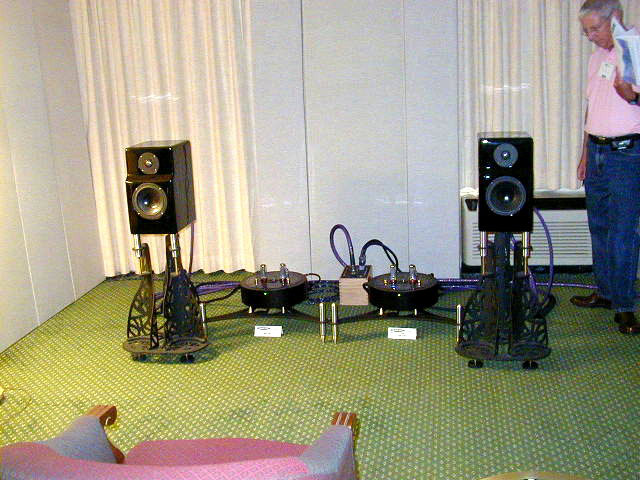
Harmonic Precision Caravelle Compact Monitors ($5k) are seen here atop the ultra sophisticated Sistrum isolation stands. Amplifiers are the musical Thor TTA-30 monoswhile digital was by way of dCS using the Verdi transport, Verona external clock and Elgar dac. All cabling throughout was Harmonic Tech Cyber Light. The sound was quite open, detailed and liquid; exactly what you’d expect using Thor amplification. I was taken by the Caravelle‘s ability to disappear so completely right there before me. I’m told this loudspeaker sports a tuning device on its rear that allows for users to adjust its resonant (harmonic) frequency to ones delight. I am hoping to get a review pair in the not too distant future. Stay tuned.
________________
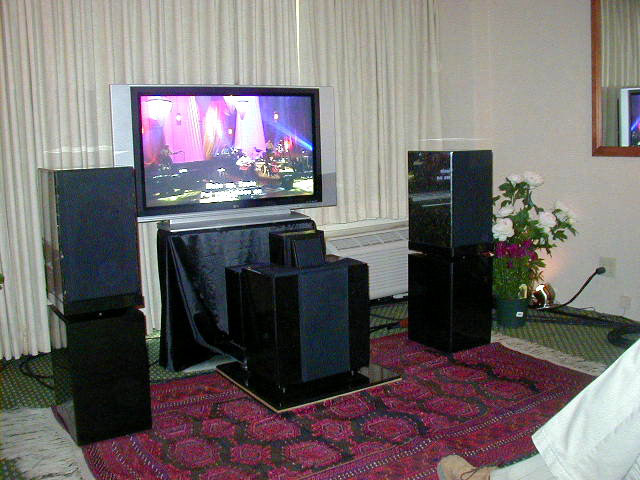
Dale Pitcher of Intuitive Design showed quite an impressive home theater demo using their Pinnacle, one of the biggest dedicated center channels I’ve seen sandwiched between a pair of mains sitting atop Coordinate Powered Stands using internally powered 300-watts of amplification. This room also featured the active anti-vibration device platforms from Halcyonics which I personally use and find vital to ridding my Reimyo CD player of harmful vibrations.
________________
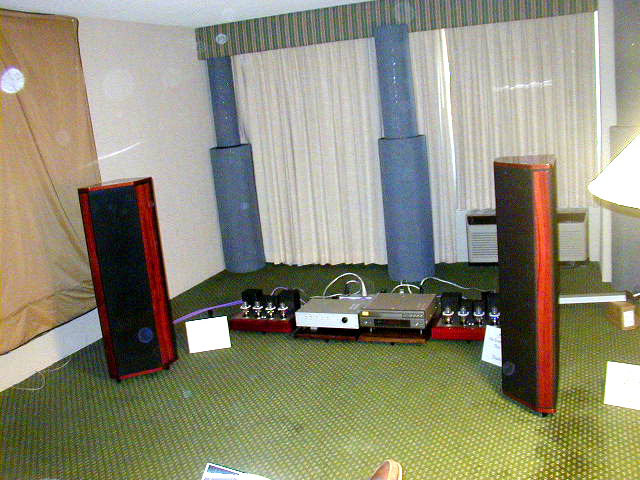
ESP’s Sean McCaughan’s introduced a scaled down version of his reference Concert Grand SI in the new and more affordable Bodhran SE loudspeakers ($16k). Driven by the heavenly Concert Fidelity 6B4G Fusion mono amps ($28k) and Concert Fidelty CF-40 preamp ($14K) that had me engrossed back at the ’04 CES, this was the perfect opportunity to hear this setup again minus the bigger Concert Grands and Alex Paychev excellently modified Philips 1000 SACD Player (this room boasted a John Tucker modified Denon 3910 from Exemplar Audio). Needless to say, the Bodhran’s did not disappoint. In fact, I was so smitten by the luxuriously expansive depth and soundstaging capabilities of this smaller model, I questioned Mike Verretto of Critical Mass Inc. and ESP’s distributor, what the differences in the two models were that would justify one being more than double the price (the Concert Grand list for $40k) After a few minutes of listening between discussions I got a clearer picture. Well, neither model has removable grills which makes it hard to see what lurks behind the cloth but the Concert Grand’s sport twice the amount of drivers (in a compound configuration) and were designed for “take no prisoner, state of the art” performance.
The one thing both models have in common – which in time will become their hallmark – and a bi-product of their odd build and well executed design, is their ability to throw images backward and away from the listener in layers upon layers of instruments. This is no secret. Years back, the original ESP Harps that guru and pal Bill Brassington proudly owned, threw such a wonderful sense of depth and image coherency that it still stands as one of my most memorable experiences. Bill would faint if had the chance to hear this new and improved version in the Bodhrans SE’s. Congrats Sean!
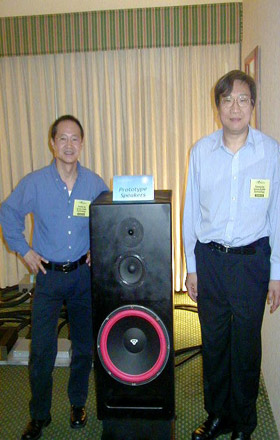
Never judge a book by its cover! New cable company Sunny Cable demonstrated their Time Coherent Technology using a prototype loudspeaker that employs internally modified crossovers using their patent-pending technology but an exterior that dare I say was quite unattractive. Sunny Lo (above right) and Sunny Cable’s prez Andre Au still were able to get some startling sonic results considering the less than reference-caliber Cerwin Vega woofer staring right at me. Mr. Lo’s point might have been missed by some but I think most got the message: this patent-pending technology works regardless of how attractive, expensive or inexpensive your loudspeakers may be. Using this technology within a loudspeaker’s crossover, Sunny Lo states “finally, you get the best of Electrostats, bipolar and dynamic drivers in terms of dynamics, three-dimensionality and accurate tonal balance combined into one.”
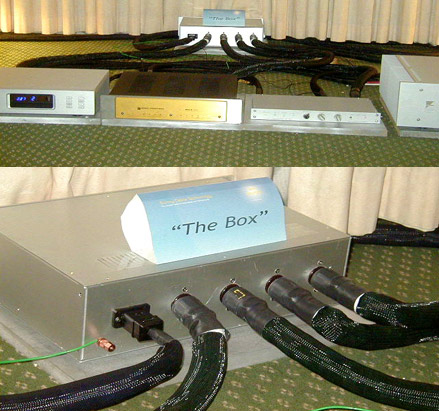
This was my first time hearing this loudspeaker and I must say that it was unusually delicate and open, conveying a sense of realism that is rare in my opinion. And this with a modified (using Sunny Technology) Sonic Frontiers SFD-2 dac strapped to an Ayre Acoustics CX-7e CD player/transport and V-1xe amplifier (also modified with Sunny Technology). Preamplifier was the highly touted H-CAT P12-B. Once I got past the big box in front of me (I admit I had to close my eyes) there was something happening with this room that was rather unique….
Sunny Cable on the other hand is something I am quite familiar with and will state here for the record it is nothing short of stellar. The 1000 series used here throughout was connected to their newest arsenal known only as “The Box.” It is not an AC line conditioner, filter and is devoid of internal limiters and transformers. Further, it won’t protect your system against lightening strikes. What Mr. Lo calls “an extension of our patent pending technology in a box” My hope is that once Sunny Cable gets their patents approved they’ll be more willing to share on what makes these cables different from the rest.
________________
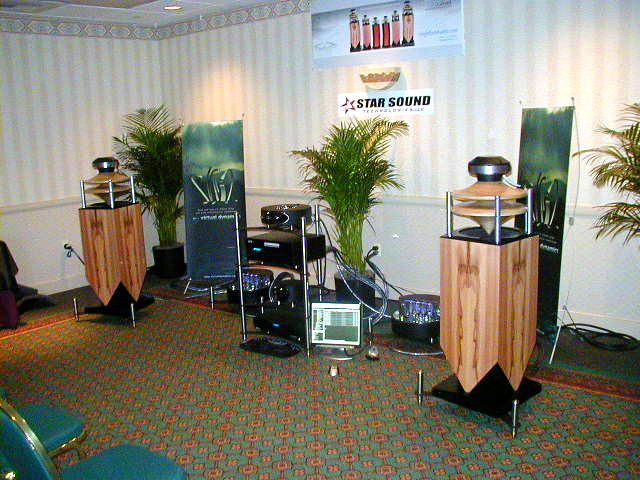
Ted Linblad of High End Audio, Vince Sanders of VRS Audio Server fame, Robert Maick of Sistrum Platforms and Rick Schultz of Virtual Dynamics formed a sonic alliance that proved one of the best sounds at the show. The Duevel Jupiter loudspeakers ($27k) were sounding exquisite in this suite replete with Sistrum platforms under everything except the chairs. The Thor Electronics TPA-60 mono amps ($17.5k) and TA-1000 preamplifier ($10k) never sounded more musically delightful to these ears. Vince Sander’s Music Server continues to haunt me with each listening session and understanding of where the future of digital is heading. Employing Schultz’s reference Revelation cables throughout (except for the innards of the Duevel Jupiter’s which use Stealth Audio cables exclusively). First off, the Jupiter’s possessed an uncanny ability to focus instruments on the outside of their physical plane in a way that I’ve not heard from anything else except perhaps the big MBLs. I am acutely aware of Rick Schultz’s Revelation Series cables and the abilities they have at intense image specificity among their many other attributes. That said, I’ve not heard them lock images in space outside of the loudspeakers in this manner. In addition, the Thor electronics had a very sweet, yet delicate and detailed presentation. Not the bodacious bass or lack thereof one gets from the mega-hundred-watt approach. This was super musical in a way that makes one forget about how high or low the frequency extremes go.
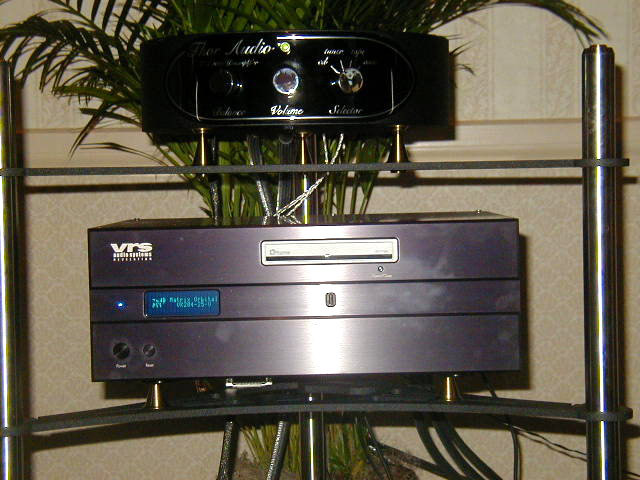
Intimately aware of all of these components less the VRS Music Server, I was astonished by the overall musicality the Duevels presented via these worthy components. If synergy has a trademark this must have been it.
|
|
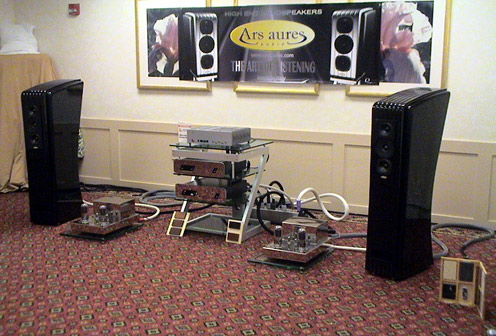
Lee Landesburg of Landes Audio, another New Jerseyite showed the best of the best in his loudspeakers that featured the alluring Ars Aures Midi Sensorial loudspeakers ($19k) driven to excellent sonic effect via a pair of Art Audio Quartet amplifiers ($13k). Digital transport was the impressively built Ensemble ($7500) while Gill Audio’s Elise DAC ($6500) and Alana preamplifier ($4500) splendidly supplied front-end duty. AC conditioner was Audio Excellence Power Wing while all cabling was by way of new comer Dynamic Design. The room’s sonics were capable of getting you to sit and forget about everything else. Soothing highs and impressive lows, considering the 845s modest 45-50 watt rating kept me passing CD after CD of my favorite tunes. I have to say, considering show conditions and all, the setup was excellent and it never hurts that this was a room of considerable size. Bill Artope of Dynamic Design and Landesburg hit a home run with this room’s sonics making this room one of the more relaxing venues. Congrats.
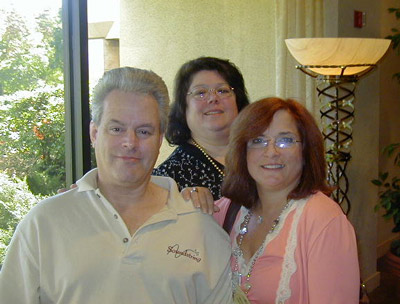
Soundstring cable designer Jed Hacker, is shown surrounded supporters Lisa Nannarone (center) and Mary Lou, all native NY’ers. One of the first things I place on my To Do list when visiting a new city is map out their best restaurants. Hacker, Lisa, Mary Lou and I found a highly recommended steak house downtown Denver. Considering how spoiled life is having lived around the corner from Peter Luger, one of most poplular steak houses, I must confess the rare quarter house steak dinner I chose was delicious. It also served as a near perfect antidote against the altitude because I felt perfect directly after leaving.
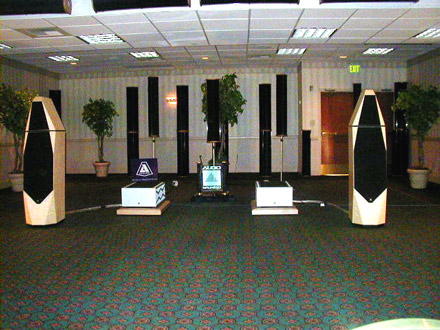
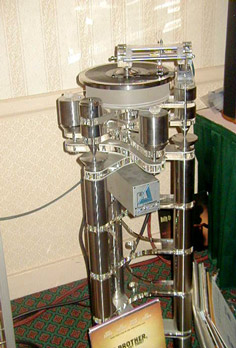 Avalon Acoustics introduced a showstopper in their newest reference Isis loudspeaker ($58k). This loudspeaker boasts all proprietary neodymium magnet drivers from Accuton appears a first of its kind. Using all new drivers; larger diamond tweeter (called the Black Diamond) and redesigned 13″ Eton woofers (two per side) along with a modified ceramic 7″ midrange makes this five-feet tall, 225 lb, transducer quite a sonic marvel.
Avalon Acoustics introduced a showstopper in their newest reference Isis loudspeaker ($58k). This loudspeaker boasts all proprietary neodymium magnet drivers from Accuton appears a first of its kind. Using all new drivers; larger diamond tweeter (called the Black Diamond) and redesigned 13″ Eton woofers (two per side) along with a modified ceramic 7″ midrange makes this five-feet tall, 225 lb, transducer quite a sonic marvel.
Equipment-wise, a slew of Boulder electronics occupied space and featured their 2050 mono amps and 2020 DAC, 2010 Balanced Preamplifier and 2008 Phono Pre. Transport used was the very attractive Macintosh 1000 (when is Boulder designing their own transport?) while all cabling featured Tara Labs Omega series. One serious looker was the new Clear Audio Master Reference turntable (photo left). First thing first, I couldn’t believe the sound coming from this ‘table. I am not your raging vinyl nut by no means and though I own quite a bit records (oldies) with a couple of turntables, including the spanking new Clear Audio Anniversary ‘table replete with the TQ-I arm), nothing I’ve heard in my home via analogue could compete with the Master Reference I heard via these electronics. The sound simply had no identity to a source. It sounded simply like music. This from a show room no less. Bravo!
_________________
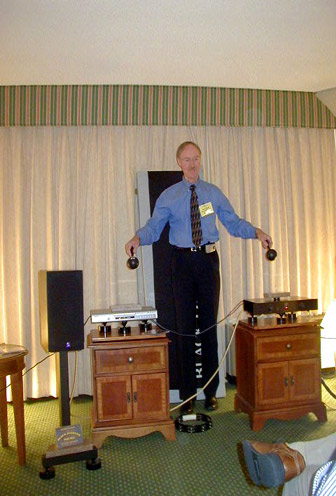 Ron Myer of RMR (Ron Meyer Records) and Encore Performance Records put on a great demo showing how close to life his recordings are. Using modest electronics (so modest I forgot their names) strictly to make a point, and tons of Black Diamond Racing products Myer demonstrated how difficult it was to distinguish between live instruments and his recordings when done correctly. Meyer informed me the Maracas and Tambourine in the demo were the very same ones used in the recording. Myer’s recording equipment isn’t however cheap. Using the best from dCS, Sony, Nagra, Neumann and B & K to name but a few, Meyer spent the better part of 22 years in the field and has accumulated a great intuition for what constitutes great recordings. I’ve listened to his CDs for years and I’m told those discs are nothing compared to what he’s brought here to this event. I’m looking forward to getting his newer releases. Check his website athttp://www.eprgoldcds.com/index.htm
Ron Myer of RMR (Ron Meyer Records) and Encore Performance Records put on a great demo showing how close to life his recordings are. Using modest electronics (so modest I forgot their names) strictly to make a point, and tons of Black Diamond Racing products Myer demonstrated how difficult it was to distinguish between live instruments and his recordings when done correctly. Meyer informed me the Maracas and Tambourine in the demo were the very same ones used in the recording. Myer’s recording equipment isn’t however cheap. Using the best from dCS, Sony, Nagra, Neumann and B & K to name but a few, Meyer spent the better part of 22 years in the field and has accumulated a great intuition for what constitutes great recordings. I’ve listened to his CDs for years and I’m told those discs are nothing compared to what he’s brought here to this event. I’m looking forward to getting his newer releases. Check his website athttp://www.eprgoldcds.com/index.htm
_________________
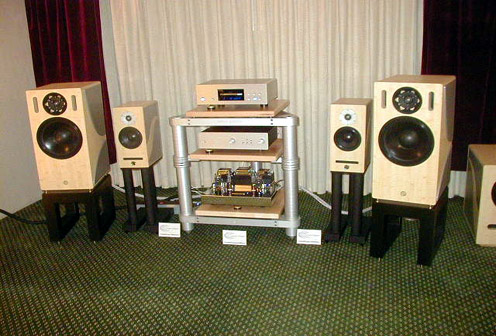
Escalante Design debuted their newest family member in the Fremont ($15k), shown besides a pair of Pinyon monitors ($6900). Anyone who has seen a pair of Pinyon’s know they’re not small monitors in the traditional sense. Yet, next to the Fremonts…I guess they can now officially be considered small monitors…that is, by Escalante’s standards. Essentially, what you have in the Fremont is a 93 dB efficient, stand-mounted monitor that employs the services of dual 12″ mid/woofers to serve up the best midrange as well as low-end proficiency (a two-way monitor using two 12s! This may be a first in monitor design). Designer Tierry Budge, known for his heroic Talon Khorus and Roc subwoofer designs of years back, has taken the best of that design goal, coupled with his latest findings and produced this, his best to date. Standing 28″ tall, 14″ in width and 18″ deep, this has to be the Charles Atlas of stand mounted loudspeakers. Comfortable being driven by 10 watts or 1000, 75 or 125 dB, the Fremont is at home in the home theater domicile as well as the audiophile’s two-channel rig.
Shown on the beautiful and familiar Acoustic Dreams rack($6k) is the Esoteric X0-1 SACD/CD Player ($13k). Preamplifier was by way of the Modwright 9.0SE ($2200) while amplification was both the Art Audio Jota ($8800) and Butler Audio’s 2250 ($3295). Cabling was by Crystal Cable while power cords as well as AC conditioning was by way of Shunyata Research.
_________________
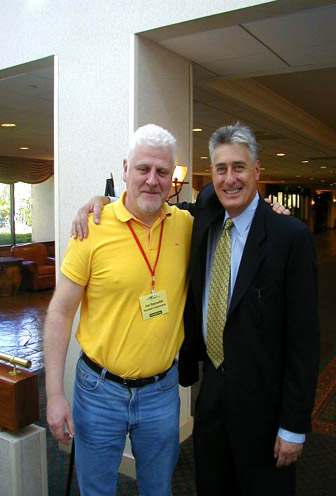
Nordost’s Joe Renolds and Echo Buster’s Mike Kochman take a pause for the cause.
Tyler Acoustics put together an impressive sounding room that featured their Tyler Acoustics Linbrook System II ($3500). I too have a pair of these very musical delights and find them to be among the fewaffordable reference-caliber loudspeakers. Here they are being driven by an all Coda setup that again was featuring Crystal Cable throughout. CD Player was the Jolida JD100. Once again, here’s high-end sound done on a modest budget. Hats off to another excellent sounding room.
_________________
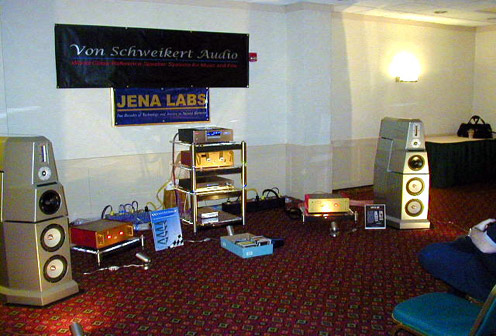
The Von Schweikert Audio Larkspur suite featured once again the formidable VR9 loudspeaker ($60k) driven by a pair of vertically bi-amped dartZeel amplifiers ($18k ea) and new preamplifier ($?). EMM Labs dac and transport were providing all the digital wizardry and I must say the sound was quite good compliments of Jena Labs cabling as usual. I didn’t get the chance to sit and listen here as much as I would have due to fact there was much to see that I had not yet heard. Being familiar with this setup didn’t get me as excited as the visitors seeing these electronics for the first time. The time I did have to sit was as impressive as the first. The sound was dynamic, warm and inviting in the way only the VR9s can recreate.
_________________
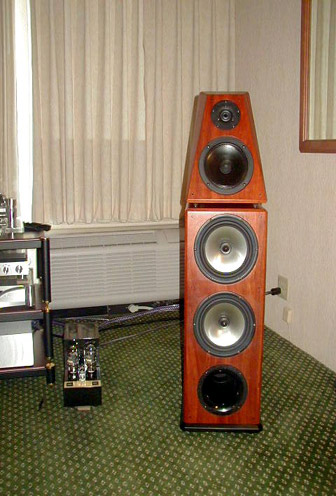
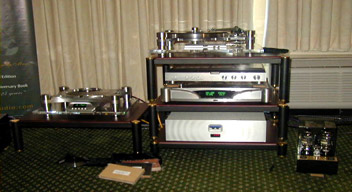 Rusty Taub of Audiotion LLC, featured the VR4 SR loudspeaker ($8k) in a dark cherry veneer driven by Kevin Hayes’ VAC Music Block amplifiers. Digital as well as analogue was all Oracle electronics. Oracle’s CD2000 Transport ($7k) and 1000 DAC/pre ($7k) were put to good use next to an Oracle Delphi MkV ‘table with SME-345 tonearm and Dynavector XX2 Cartridge. Notice AC noise was kept far away thanks to the Audience AdeptResponse AC Conditioner. All cabling was via Analysis Plus. I remember asking Rusty specifically whether the music was analogue because it sounded rich in overtones; something that only the best of the best in digital affords. His response was “yes, it is vinyl.” The old boy can still hear! No one with common sense would qualify this room as affordable, but considering the other VR9 setup, you’d have to assume this is the affordable option (though the VR4jr is half the price). I still enjoyed the sound emanating from this room into the hallway right up to the listening chair.
Rusty Taub of Audiotion LLC, featured the VR4 SR loudspeaker ($8k) in a dark cherry veneer driven by Kevin Hayes’ VAC Music Block amplifiers. Digital as well as analogue was all Oracle electronics. Oracle’s CD2000 Transport ($7k) and 1000 DAC/pre ($7k) were put to good use next to an Oracle Delphi MkV ‘table with SME-345 tonearm and Dynavector XX2 Cartridge. Notice AC noise was kept far away thanks to the Audience AdeptResponse AC Conditioner. All cabling was via Analysis Plus. I remember asking Rusty specifically whether the music was analogue because it sounded rich in overtones; something that only the best of the best in digital affords. His response was “yes, it is vinyl.” The old boy can still hear! No one with common sense would qualify this room as affordable, but considering the other VR9 setup, you’d have to assume this is the affordable option (though the VR4jr is half the price). I still enjoyed the sound emanating from this room into the hallway right up to the listening chair.
_________________
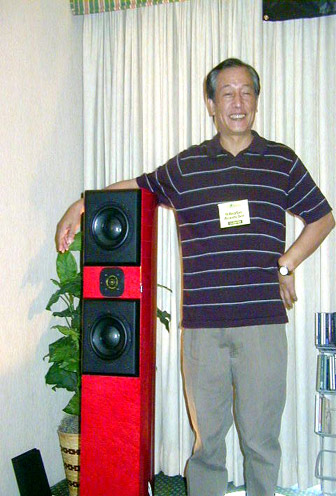
Robert Lee of Acoustic Zen smiles proudly next to his newest product in the Adagio loudspeaker ($3700). Employing a Kapton ribbon tweeter (don’t let the look fool you) and dual 6 1/2″ Underhung drivers, Lee informs this loudspeaker is up, running and ready for audiophiles of the world on a budget. A full fledge of Edge amplifiers were chosen to bring out the best in Lee’s design and they did not disappoint. I look forward to having a pair in for review in the not too distant future.
_________________
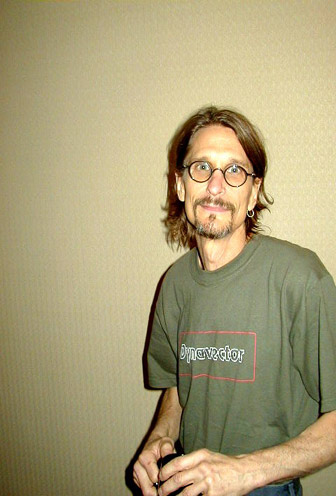
Jeff Catalano of High Water Sound, located in New York City is one of those rare type personalities in that he intuitively has the ear for matching the right components together. If you think that’s easy, go to any local audio salon, then go and visit High Water Sound. An audiophile who chooses to show his passion through exquisite components and careful matching is what Catalano is all about. Rare indeed.
_________________
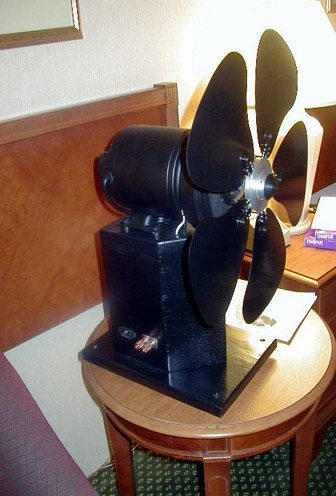 Came into this room to cool off and almost caught a heart attack!! Eminent Technology, the company known the world over for their planar loudspeakers introduced their TRW 17 Infrasonic Woofer ($12K). For this reviewer, the TRW has to be the most innovative product these ears have heard and eyes have seen in a very, very long time. Okay, to really know more you’ve got to visit their website athttp://www.eminent-tech.com/main.html. It’s a known fact that in order to produce anything audible (on a consistent level) below 20 Hz requires tons of amperage, power and one hell of a subwoofer. Moreover, most will not argue that to hear anything below, say 16 Hz is virtually impossible. Well, to date, I’ve not heard anything produce the effects heard as well as felt in this room using this propeller-type invention. I’m convinced, as well as everyone else in the room who took the time to sit through a demonstration, that this is perhaps the most impressive low-end I’ve ever heard. Will something like this work in a true two-channel setup? Dunno. I think the better question is, how much music exists out there that features octaves below 15 Hz, excepting classical music using those big pipe organs?
Came into this room to cool off and almost caught a heart attack!! Eminent Technology, the company known the world over for their planar loudspeakers introduced their TRW 17 Infrasonic Woofer ($12K). For this reviewer, the TRW has to be the most innovative product these ears have heard and eyes have seen in a very, very long time. Okay, to really know more you’ve got to visit their website athttp://www.eminent-tech.com/main.html. It’s a known fact that in order to produce anything audible (on a consistent level) below 20 Hz requires tons of amperage, power and one hell of a subwoofer. Moreover, most will not argue that to hear anything below, say 16 Hz is virtually impossible. Well, to date, I’ve not heard anything produce the effects heard as well as felt in this room using this propeller-type invention. I’m convinced, as well as everyone else in the room who took the time to sit through a demonstration, that this is perhaps the most impressive low-end I’ve ever heard. Will something like this work in a true two-channel setup? Dunno. I think the better question is, how much music exists out there that features octaves below 15 Hz, excepting classical music using those big pipe organs?
Issues? Yeah, I got a few. 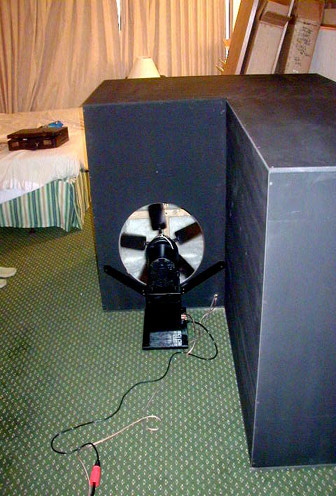 Namely space. This propeller-type sub needs plenty of it. Perhaps a closet or a room unused would prove adequate. The photo right shows the demo unit was in an adjacent room with a enclosure built around it leading to the room where I, along with maybe a half-dozen others, sat and listened in total amazement. The room’s walls, pictures and window literally shook for as long as test tones played. I’m not talking of the type tones that sounded boomy, distorted or even fake. These tones sounded like what a Talon Firebird only hints at for a fraction of a second, if at all on some of those movie soundtracks like the 5th Element and Braveheart. All I can say is this is one of those subs that French audiophile Jean Yves needs to experiment with. He’s both the money, the room and the equipment to benefit from such a device. Hands down, the most impressive demo at the show. Who would have thought a music lover like me would be so taken by something like this. Presently, I’m cleaning out one of my closets….
Namely space. This propeller-type sub needs plenty of it. Perhaps a closet or a room unused would prove adequate. The photo right shows the demo unit was in an adjacent room with a enclosure built around it leading to the room where I, along with maybe a half-dozen others, sat and listened in total amazement. The room’s walls, pictures and window literally shook for as long as test tones played. I’m not talking of the type tones that sounded boomy, distorted or even fake. These tones sounded like what a Talon Firebird only hints at for a fraction of a second, if at all on some of those movie soundtracks like the 5th Element and Braveheart. All I can say is this is one of those subs that French audiophile Jean Yves needs to experiment with. He’s both the money, the room and the equipment to benefit from such a device. Hands down, the most impressive demo at the show. Who would have thought a music lover like me would be so taken by something like this. Presently, I’m cleaning out one of my closets….
Stereo Times Masthead
Publisher/Founder
Clement Perry
Editor
Dave Thomas
Senior Editors
Frank Alles, Mike Girardi, Russell Lichter, Terry London, Moreno Mitchell, Paul Szabady, Bill Wells, Mike Wright, and Stephen Yan,
Current Contributors
David Abramson, Tim Barrall, Dave Allison, Ron Cook, Lewis Dardick, John Hoffman, Dan Secula, Don Shaulis, Greg Simmons, Eric Teh, Greg Voth, Richard Willie, Ed Van Winkle, Rob Dockery, Richard Doron, and Daveed Turek
Site Management Clement Perry
Ad Designer: Martin Perry





Be the first to comment on: RMAF 2005